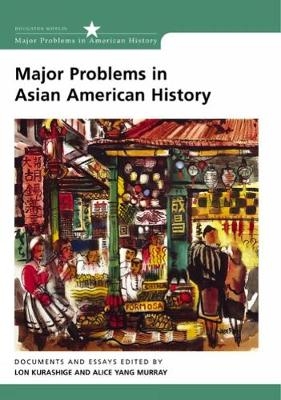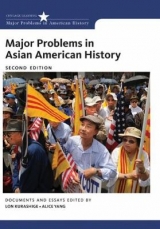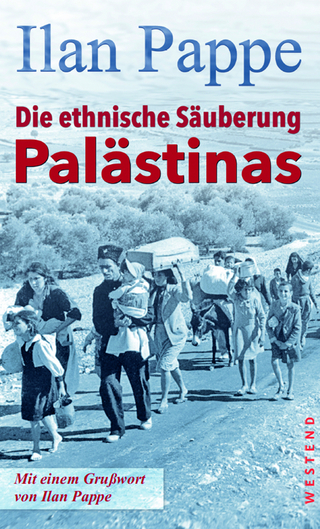
Major Problems in Asian American History
Houghton Mifflin (Verlag)
978-0-618-07734-2 (ISBN)
- Titel erscheint in neuer Auflage
- Artikel merken
Lon Kurashige is associate professor of History at the University of Southern California. He is author of PERFECT STORM OF EXCLUSION: ASIAN AMERICANS, POLITICAL DEBATE, AND THE MAKING OF A PACIFIC NATION (Chapel Hill: University of North Carolina Press, 2016) and JAPANESE AMERICAN CELEBRATION AND CONFLICT: A HISTORY OF ETHNIC IDENTITY AND FESTIVAL, 1934–1990 (University of California Press, 2002), winner of the History Book Award from the Association for Asian American Studies in 2004. He co-edited “Conversations in Transpacific History,” a special edition of Pacific Historical Review (2014). His article “Rethinking Anti-Immigrant Racism: Lessons from the Los Angeles Vote on the 1920 Alien Land Law” won the Carl I. Wheat prize for best publication to appear in the Southern California Quarterly between 2012 and 2014. His writings have appeared in Journal of American History, Pacific Historical Review, Reviews in American History, and other academic journals. Dr. Kurashige also has co-authored a college-level textbook: GLOBAL AMERICANS: A HISTORY OF THE UNITED STATES (Cengage, 2018). Alice Yang, assistant professor of History at the University of California-Santa Cruz, received her Ph.D. from Stanford University in 1994. Her academic interests include Asian American history, women’s history, and twentieth-century U.S. history. Her most recent publication is an article entitled “Ilse Women and the Early Korean Community,” which was published in KOREAN AMERICAN WOMEN: LIVING IN TWO CULTURES and reprinted in UNEQUAL SISTERS: A MULTICULTURAL READER IN U.S. WOMEN’S HISTORY.
1. Framing Asian American History
ESSAYS
Roger Daniels, Neglect and Distortion of Asian Americans by American Historians
Ronald Takaki, The Centrality of Racism in Asian American History
Sylvia Yanagisako, Rethinking the Centrality of Racism in Asian American History
Paul Ong, Edna Bonacich, and Lucie Cheng, Capitalist Restructuring and the New Asian Immigration
Bill Ong Hing, What Does It Mean to Be Asian American?
2. Colonization, Pacific Markets, and Asian Labor Migration to the United States Before the Civil War
DOCUMENTS
Chinese Emperor Decries Market Expansion in South China, 1727
An American Trader Recommends a Route from California to China, 1850
Writer Ralph Waldo Emerson Excoriates Chinese Civilization, 1824
Hawaiians Petition the Privy Council to Halt Foreign Influence in the Islands, and the Council Replies, 1845
A Foreigner Speculates on Hawaiian Land Acquisition, 1849
American Commodore M.C. Perry Opens Up the Japanese Market, 1856
New York Times Heralds New Trade with China and Japan, 1858
Researcher Traces Early Nineteenth-Century Origins of Filipino American Family, 1988
ESSAYS
Yong Chen, Origins of Chinese Emigration to California
Ronald Takaki, Native and Asian Labor in the Colonization of Hawai''i
3. The Work of National Expansion in the American West, 1848-1908
DOCUMENTS
Writer J. D. Borthwick Observes Chinese Miners in California, 1857
Chinese Laborers Report on a Race Riot at Rock Springs, Wyoming Territory, 1885
Journalist Helen Grey Exposes the Activities of a Chinese Brothel Owner, 1899
Chinese Merchant Lee Wong Hing''s Store in Holyoke, Massachusetts, 1904
Leading Japanese Intellectual Encourages Westernization, 1875
Japanese Newspaper Jiji Shimpo Views Emigration as a Sign of Japan''s Military Power, 1896
Japanese Government Criteria for Emigrants to Hawai''i, 1885
Japanese Official Condemns Brutal Working Conditions on Hawaiian Plantations, 1885
ESSAYS
Sucheng Chan, Shifting Chinese Immigrant Employment
Akira Iriye, Japanese Expansion in California
4. Confronting Immigration Exclusion, 1860s-1920s
DOCUMENTS
Editor Henry George Supports Chinese Exclusion on Economic and Racial Grounds, 1869
The Tables Turned: You Sabe Him? Kealney [Kearney] Must Go!," 1877/1878
Senator George Hoar Declares Chinese Exclusion Un-American, 1882
Chinese Exclusion Act Suspends Immigration to the United States for Ten Years, 1882
New York Chinese Merchants Oppose Renewal of Chinese Exclusion Act, 1892
Wong Kim Ark, 1904
Asiatic Exclusion League Argues for Excluding Japanese and Korean Immigration, 1908
Spokane Labor Union Derides Anti-Japanese Prejudice, 1909
Tokyo Government Protests Exclusion of Japanese Immigrants, 1924
Ray E. Chase and S.G. Pandit Critique Supreme Court Ruling Excluding East Indians from Citizenship, 1926
ESSAYS
Andrew Gyory, The Significance of Chinese Exclusion
K. Scott Wong, Chinese Responses to Exclusion
Mae M. Ngai, The Immigration Act of 1924
5. Imperialism and Anti-Imperialism in the Early Twentieth Century
DOCUMENTS
Senator Albert Beveridge Champions Philippine Colonization, 1900
Theodore Roosevelt Justifies Philippine Colonization on the Basis of America''s History of Westward Expansion, 1900
Filipino Soldiers Pray Before Surrendering to Americans, 1900
American Troops Fight in the Philippines, 1910
Filipinos Demand Independence, 1908
Indian Nationalists and American Journalist Disagree Over the Route to India''s Independence, 1923
Indian Immigrant Mohan Singh Recounts His Education in the United States, circa 1924
Korean Congress Declares Independence from Japanese Rule, 1919
Korean Immigrant Margaret Pai Joins the Korean Independence Movement, 1919
ESSAYS
Stefi San Buenaventura, The Colors of Manifest Destiny in the Philippines
Joan M. Jensen, Exporting Independence to Colonial India
Lili Kim, Korean Independence Movement in Hawai''i and the Continental United States
6. Orientalism and Popular Culture, 1904-1930s
DOCUMENTS
Writer Jack London Decries the New Yellow Peril, 1904
Dance of the Igorrotes, Louisiana Purchase Exposition, St. Louis, 1904
Filipino Immigrant Condemns Representation of Group, circa 1924
Anti-Japanese Monologue in Wallace Irwin''s Seed of the Son, 1926
Writer Sui Seen [Sin] Far Reveals Private Lives of Chinese Merchant Wives, 1897
Sociology Graduate Student Rose Hum Lee Lists American Beliefs About the Chinese, 1927
MGM Studios Strategizes Advertisement for The Painted Veil, 1934
Harold R. Issacs Addresses the Historical Significance of Pearl Buck''s Portrayal of the Chinese, 1958
ESSAYS
Robert Rydell, The Filipino Village at the 1904 World''s Fair
Karen Janis Leong, The Radicalized Image of Anna May Wong
7. Interethnic Tensions and Alliances in the 1920s and 1930s
DOCUMENTS
A Chinese American Woman Identifies with Japanese American Marriage Practices, circa 1924
A White American Woman Compares Marriage to Chinese and Japanese Husbands, circa 1924
Indian Immigrant Inder Singh Discusses His Marriage with a Mexican Woman, 1924
A Filipino Immigrant Is Shocked by Sexual Freedom in the United States, circa 1924
Sociologist Emory Bogardus Analyzes an Anti-Filipino Riot, 1930
Time Magazine Reveals Sexual Basis for Filipino Repatriation, 1936
White Landowner Dr. E.E. Chandler Describes an East Indian Agricultural Community, 1924
Writer Carlos Bulosan Conveys the Dangers of Filipino Labor Organizing (1930s), 1943
Labor Leader Karl Yoneda Recalls Japanese Interethnic Organizing (1930s), 1978
ESSAYS
Eiichiro Azuma, Labor Conflict Between Japanese and Filipinos in the California Delta
Rhacel Salazar Parrenas, Alliances Between White Working-Class Women and Filipino Immigrant Men
8. Americanization and the Second Generation, 1920-1942
DOCUMENTS
Flora Belle Jan Longs for Unconventionality and Freedom, 1924
Connie Tirona Recalls Growing Up Filipino American (1930s and 1940s), 1995
Dora Yum Kim Recalls Growing Up Korean American in Chinatown (1920s, 1930s, and 1940s), 1999
Taishi Matsumoto Bemoans Limited Employment Opportunities for Nisei, 1937
Tokutaro Slocum Debates the Nisei Stand on Sino-Japanese War, 1938
Japanese American Newspaper Kashu Mainichi Heralds Biculturalism of Beauty Queen, 1940
American Intelligence Officer Promotes Nisei Americanization, 1942
San Francisco Japantown, 1942
Middle-Class Japanese American Family Before Evacuation, 1942
ESSAYS
Judy Yung, Second-Generation Chinese American Women
Lon Kurashige, The Problem of Nisei Biculturalism
9. War, Race, and the Meaning of Citizenship, 1941-1988
DOCUMENTS
Sociology Graduate Student Rose Hum Lee Describes How World War II Changed the Lives of Chinese Americans, 1942
Filipino Regiment Member Manuel Buaken Fights for Freedom, 1943
Lieutenant General John L. DeWitt Recommends the Removal of Japanese Americans from the West Coast, 1942
Japanese American Mike Masaoka Vows to Cooperate with Government Removal Plans, 1942
Journalist James M. Omura Condemns the Mass Exclusion of Japanese Americans, 1942
The Fair Play Committee Calls on Nisei, Second-Generation Japanese Americans, to Resist the Draft Within the Heart Mountain Internment Camp, 1944
Justice Frank Murphy Criticizes the Supreme Court''s "Legalization of Racism," 1944
A Government Commission Proclaims Internment a "Grave Injustice," 1982
A District Court Acknowledges Government Misconduct Before the Supreme Court During World War II, 1984
ESSAYS
Theo Gonzalves, Filipino Veterans of World War II on Citizenship and Political Obligation
Alice Yang Murray, The Internment of Japanese Americans
10. Asian Americans and the Cold War, 1945-1965
DOCUMENTS
Novelist James Michener Portrays Romance Between Japanese Women and White Soldiers in Sayonara, 1953
A Hollywood Poster Sells Interracial Love and the Exoticism of Japan in the Film Sayonara, 1957
Social Worker Bok-Lim C. Kim Describes the Social Isolation and Alienation of War Brides (1947), 1979
President Harry S Truman Vetoes an Immigration and Naturalization Bill, 1952
Congress Expands Immigration and Naturalization Rights for Asian Immigrants, 1952
Former Communist Party Member Ichiro Izuka Denounces Communists in Hawai''i, 1947
Honolulu Record Editor and Labor Leader Koji Ariyoshi Describes the Arrest of Seven Suspected Communists in Hawai''i (1951), 2000
Franklin Woo Remembers Attacks on Chinese Immigrant Leftists Who Supported Communist China (1950s), 1973
Pei Chi Liu Recalls Why He Campaigned Against Communism as a Leader of the San Francisco Chinatown Branch of the Kuomintang Party (1950s), 1973
ESSAYS
Paul R. Spickard, Marriages Between American Men and Japanese Women After World War II
Arlene de Vera, The United States Government Tries to Deport Filipino Labor Leaders
Xiaojian Zhao, The Immigration and Naturalization Service''s Campaign Against Chinese Americans During the Cold War
11. Post-1965 Immigration and Asian America
DOCUMENTS
The Immigration and Nationality Act of 1965 Repeals Discriminatory Policies Toward Asian Immigrants, 1965
Statistics on Immigration Trends: Immigration Trends by Race and Decade, 1820-1980; Immigration by Country of Origin, 1820-1980
Perla Rabor Rigor Compares Life as a Nurse in the Philippines and America, 1987
The Supreme Court Endorses Bilingual Education, 1974
Asian Americans Debate the Pros and Cons of Bilingual Education, 1998
Asian Immigrants Transplant Religious Institutions, 1994
Korean American Professor Elaine Kim Discusses Problems in Building Coalitions Between Asian Immigrants and Other Communities of Color, 1998
Indian Immigrant Sarita Sarvate Criticizes the "Brain Drain" from the Third World, 2000
ESSAYS
Catherine Ceniza Choy, A Transnational History of Filipino Nurse Migration
Edward J.W. Park, The Los Angeles Civil Unrest Transforms Korean American Politics
12. Refugees and Their Struggles in Asia and America, 1975-2000
DOCUMENTS
Lang Ngan, a First-Wave Refugee, Compares Life in Vietnam and the United States (1975), 1991
Cambodian Refugee Bun Thab Remembers the Atrocities of the Khmer Rouge, 1993
Le Tan Si Writes a College Essay About His Terrifying Escape by Boat from Vietnam (1979), 1989
An Account of Cultural and Religious Conflict Between American Doctors and Hmong Refugees in a Thai Refugee Camp, 1982
Xang Mao Xion Tells His Daughter of the Problems Hmong Parents Face in America, 1994
Golden Venture Refugees Wage a Hunger Strike to Protest Their Detention, 1995
Business Consultant George P. Koo Criticizes Harry Wu''s Campaign Against the Chinese Government, 1996
Chinese Refugee and Human Rights Activist Harry Wu Criticizes U.S. Trade Policies Toward China, 2000
ESSAYS
Gail Paradise Kelly, Education and Sex Role Socialization of Vietnamese Immigrant Women
James M. Freeman and Usha Welaratna, Vietnamese and Cambodian Views of "Successful" Adjustment in America
13. Panethnicity, Asian American Activism, and Identity, 1965-2000
DOCUMENTS
Activist Amy Uyematsu Proclaims the Emergence of "Yellow Power," 1969
Asian Americans Protest Against the Vietnam War in Los Angeles, late 1960s
A Skit on Sexism Within the Asian American Movement, 1971
A Song of Struggle and Solidarity by A Grain of Sand, 1973
A Government Report on the Murders of Vincent Chin and Jim Loo, 1992
Professor Dana Takagi Notes How Sexuality Complicates Definitions of "Asian America," 1999
Hawaiian Sovereignty Leader Haunani-Kay Trask Criticizes Asian "Settler" Privilege and Collaboration with Colonialism, 2000
Captain Ted W. Lieu Is Asked If He Is in the Chinese Air Force, 1999
Lawyer Angela E. Oh Describes the Significance of the Government Prosecution of Los Alamos Scientist Wen Ho Lee, 2000
Accused Spy Wen Ho Lee Describes His First Month of Imprisonment, 2000
Judge James A. Parker Apologizes to Wen Ho Lee for the Way He Was Treated by the Executive Branch, 2000
ESSAYS
Yen Le Espiritu, Panethnicity and Asian American Activism
L. Ling-chi Wang, Asian Americans and Debates About Affirmative Action
14. New Formations of Asian American Culture, 1990-2001
DOCUMENTS
A Journalist Recounts the Battle Between Writers Frank Chin and Maxine Hong Kingston over the Soul of Asian American Literature, 1990
Vietnamese Americans Condemn Depictions of South Vietnam by Le Ly Hayslip and Oliver Stone, 1994
Asian American Hip-Hop and Rap Artists Gain Recognition (1990s), 1998
The Association of Asian American Studies Rescinds a Fiction Award to Lois-Ann Yamanaka Because of Her Portrayals of Filipino Americans in Hawai''i, 1998
Silent Protest Against a Fiction Award Presented to Lois-Ann Yamanaka by the Association for Asian American Studies, 1998
A New York City Parade Celebrates India''s Independence, 2000
The Media Action Network for Asian Americans Condemns Hollywood Stereotypes, 2000
Hollywood Recruits Asian Stars from the Hong Kong Cinema Industry, 2001
ESSAYS
Candace Fujikane, Racism, Censorship, and Lois-Ann Yamanaka''s Blu''s Hanging
Sandhya Shukla, Transnational Community, Culture, and Little India
Peter Feng, Defining Asian American Cinema
15. Erasing Borders and Boundaries: Asian Americans in the Twenty-First Century
DOCUMENTS
Activist Mallika Dutt Organizes Migrant Women in Seven Countries (1995), 1997
Residents of New Elmhurst, New York, Develop Multiracial and Multiethnic Coalitions to Improve Their Neighborhood (1992), 1998
Psychologist Maria P.P. Root Proclaims a Bill of Rights for Racially Mixed People, 1996
South Asians Unite Against Bigotry Following the 9-11 Attack on the World Trade Center, 2001
ESSAYS
K. Connie Kang, At a Crossroads: California''s Diverse and Changing Asian American Population
Cynthia L. Nakashima, Approaches to Multiraciality"
| Erscheint lt. Verlag | 7.11.2002 |
|---|---|
| Verlagsort | Boston |
| Sprache | englisch |
| Maße | 164 x 237 mm |
| Gewicht | 722 g |
| Themenwelt | Geschichte ► Teilgebiete der Geschichte ► Kulturgeschichte |
| ISBN-10 | 0-618-07734-0 / 0618077340 |
| ISBN-13 | 978-0-618-07734-2 / 9780618077342 |
| Zustand | Neuware |
| Haben Sie eine Frage zum Produkt? |
aus dem Bereich



